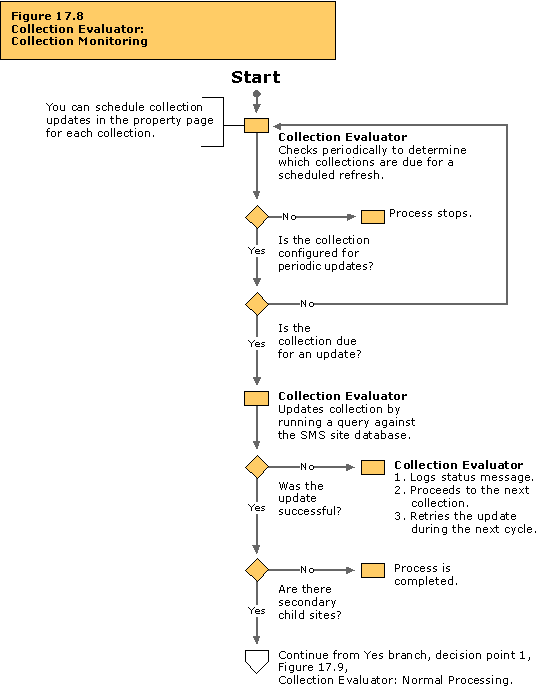Collection Monitoring
This flowchart illustrates the actions that occur to ensure that the memberships of dynamic collections are kept up-to-date. Each dynamic collection is re-evaluated according to a schedule set in the property dialog box for that collection. This flowchart describes the activity involved in these scheduled updates.
Collection monitoring activity takes place on the site server.
Tracing Information
You can trace the activity described in this flowchart by studying the status messages for the server components listed in the table below. Or, you can enable the log files for these components. You can then study the log files and status messages associated with these components to trace the activity that is actually occurring on your SMS system and compare it to the activity described in the flowchart. For more information about viewing status messages and enabling logging, see “Status Messages Versus Logging” in Chapter 16, “Introducing the SMS 2.0 Flowcharts.”
Table 17.9 Status Message Components and Log Files for Collection Evaluator: Collection Monitoring
| Server components | Log files |
|---|
| Collection Evaluator | SMS\Logs\Colleval.log |
| SMS Provider | SMS\Logs\SMSprov.log |
Troubleshooting Tips
If collections are not being refreshed at regular intervals:
- Read the status messages recorded by Collection Evaluator to pinpoint why a collection update was not successful.
- Verify that a collection update schedule is set for each collection. To do so, open the property dialog box for the collection, select the Membership Rules tab, and click Schedule. If Recurrence Pattern is set to None, this collection is not periodically refreshed.
- Determine from the Colleval.log file whether the Collection Evaluator was able to run a query against the SMS site database to obtain the latest information about a specific collection. This log file contains a record of SQL Server connectivity problems. The log file also records SQL Server environment issues related to running the query, such as the Tempdb database’s running out of space or SQL Server’s running out of memory. To determine or adjust SQL Server settings, use the SQL Enterprise Manager.
- Verify that changes to update schedules in the SMS Administrator console are written to the SMS site database through the SMS Provider by checking the SMS Provider status messages or enabling and examining the SMSprov.log file.


